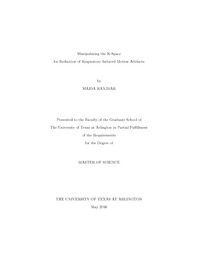
ATTENTION: The works hosted here are being migrated to a new repository that will consolidate resources, improve discoverability, and better show UTA's research impact on the global community. We will update authors as the migration progresses. Please see MavMatrix for more information.
Show simple item record
| dc.contributor.advisor | Liu, Hanli | |
| dc.contributor.advisor | Madhuranthakam, Ananth | |
| dc.creator | Ranjbar, Maida | |
| dc.date.accessioned | 2016-09-28T18:52:14Z | |
| dc.date.available | 2016-09-28T18:52:14Z | |
| dc.date.created | 2016-05 | |
| dc.date.issued | 2016-05-16 | |
| dc.date.submitted | May 2016 | |
| dc.identifier.uri | http://hdl.handle.net/10106/25931 | |
| dc.description.abstract | Respiratory induced motion artifacts, particularly those occurring in the abdomen and lung, pose a hefty problem in current diagnostic MR imaging. Application of images plagued with such artifacts not only hinder diagnosis, but may result in the enforcement of undesirably large safety margins in radiation therapy due to un-captured tumor characteristics that are concealed by the artifact. While several methods such as gated scans, breath-hold scans, variation of the K-Space acquisition trajectory, and reducing the scan time via partial acquisition or parallel imaging have been proposed as a solution, a robust and yet simple to implement remedy still remains to be proposed. This work investigates the application of partial K-Space acquisition/completion methods to correct for motion induced artifacts occurring in MR images of the abdomen; if feasible, the application of such methods to motion correction permits for the amelioration of the artifact ridden image, without a great deal of additional burdens in the clinical application of the imaging.
Our study uses the mDIXON breath-hold sequence to image an abdomen phantom mounted on an MRI compatible motion platform, programmed by trajectories that mimic undesirable common motions such as coughs/hick-ups, constant inhale and exhale that often occur during breath-hold scans. By performing a parametric study of the resulting artifact to the parameters that characterize the programmed motion trajectory, we categorize the motion artifact in terms of the underlying motion that it originated from. A set of tools are then developed that permit for the manipulation, and correction of the K-Space and the resulting image. The developed set of tools provide a mechanism that permits for the study of the evolution of the image with the acquisition of the K-Space. Using our tools, regions in the K-Space that are acquired during the occurrence of the motion can be isolated, and manipulated to compensate for the motion. By applying our methodology to our experimental data obtained in the RTR 3T MR scanner, we show that even the simplest methods such as zero padding can lead to a reduction in the intensity of the observed artifacts, there-by permitting for an amelioration of the obtained image. | |
| dc.format.mimetype | application/pdf | |
| dc.language.iso | en_US | |
| dc.subject | Motion management | |
| dc.subject | Breath-hold MRI scan | |
| dc.subject | Respiratory motion correction | |
| dc.subject | Parallel imaging and partial acquisition | |
| dc.subject | K-Space correction | |
| dc.subject | MRI compatible motion platform | |
| dc.title | Manipulating the K-Space for Reduction of Respiratory Induced Motion Artifacts | |
| dc.type | Thesis | |
| dc.degree.department | Bioengineering | |
| dc.degree.name | Master of Science in Biomedical Engineering | |
| dc.date.updated | 2016-09-28T18:54:21Z | |
| thesis.degree.department | Bioengineering | |
| thesis.degree.grantor | The University of Texas at Arlington | |
| thesis.degree.level | Masters | |
| thesis.degree.name | Master of Science in Biomedical Engineering | |
| dc.type.material | text | |
Files in this item
- Name:
- RANJBAR-THESIS-2016.pdf
- Size:
- 36.28Mb
- Format:
- PDF
This item appears in the following Collection(s)
Show simple item record


